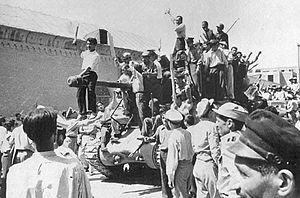1953 Iranian coup d'état
| United States involvement in regime change |
|---|
| 20th century |
|
| 21st century |
The 1953 Iranian coup d'état, known in Iran as the 28 Mordad coup d'état (Persian: کودتای ۲۸ مرداد), was the overthrow of the democratically elected Prime MinisterMohammad Mosaddegh in favor of strengthening the monarchical rule of the Shah, Mohammad Reza Pahlavi on 19 August 1953.[5] It was orchestrated by the United States (under the name TPAJAX Project[6] or "Operation Ajax") and the United Kingdom (under the name "Operation Boot").[7][8][9][10] The clergy also played a considerable role.[11]
Mosaddegh had sought to audit the documents of the Anglo-Iranian Oil Company(AIOC), a British corporation (now part of BP), in order to verify that AIOC was paying the contracted royalties to Iran, and to limit the company's control over Iranian oil reserves.[12] Upon the AIOC's refusal to co-operate with the Iranian government, the parliament (Majlis) voted to nationalize Iran's oil industry and to expel foreign corporate representatives from the country.[13][14][15] After this vote, Britain instigated a worldwide boycott of Iranian oil to pressure Iran economically.[16] Initially, Britain mobilized its military to seize control of the British-built Abadan oil refinery, then the world's largest, but Prime Minister Clement Attlee (in power until 1951) opted instead to tighten the economic boycott[17] while using Iranian agents to undermine Mosaddegh's government.[18]: 3 Judging Mosaddegh to be unreliable and fearing a Communist takeover in Iran, UK prime minister Winston Churchill and the Eisenhower administrationdecided in early 1953 to overthrow Iran's government, though the preceding Truman administration had opposed a coup, fearing the precedent that Central Intelligence Agency (CIA) involvement would set.[18]: 3 British intelligence officials' conclusions and the UK government's solicitations were instrumental in initiating and planning the coup, despite the fact that the U.S. government in 1952 had been considering unilateral action (without UK support) to assist the Mosaddegh government.[19][20][21]
Following the coup in 1953, a government under General Fazlollah Zahedi was formed which allowed Mohammad Reza Pahlavi, the last Shah of Iran (Farsi for 'king'),[22] to rule more firmly as monarch. He relied heavily on United States support to hold on to power.[13][14][15][23] According to the CIA's declassified documents and records, some of the most feared mobsters in Tehran were hired by the CIA to stage pro-Shah riots on 19 August.[5] Other men paid by the CIA were brought into Tehran in buses and trucks, and took over the streets of the city.[24] Between 200[3] and 300[4] people were killed because of the conflict. Mosaddegh was arrested, tried and convicted of treason by the Shah's military court. On 21 December 1953, he was sentenced to three years in jail, then placed under house arrest for the remainder of his life.[25]: 280 [26][27] Other Mosaddegh supporters were imprisoned, and several received the death penalty.[15]After the coup, the Shah continued his rule as monarch for the next 26 years[14][15] until he was overthrown in the Iranian Revolution in 1979.[14][15][18]
In August 2013 the U.S. government formally acknowledged the U.S. role in the coup by releasing a bulk of previously classified government documents that show it was in charge of both the planning and the execution of the coup, including the bribing of Iranian politicians, security and army high-ranking officials, as well as pro-coup propaganda.[28][29] The CIA is quoted acknowledging the coup was carried out "under CIA direction" and "as an act of U.S. foreign policy, conceived and approved at the highest levels of government".[30]




Geen opmerkingen:
Een reactie posten